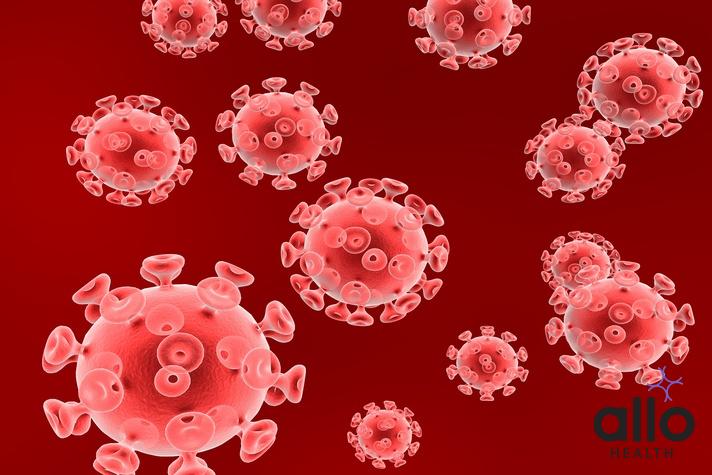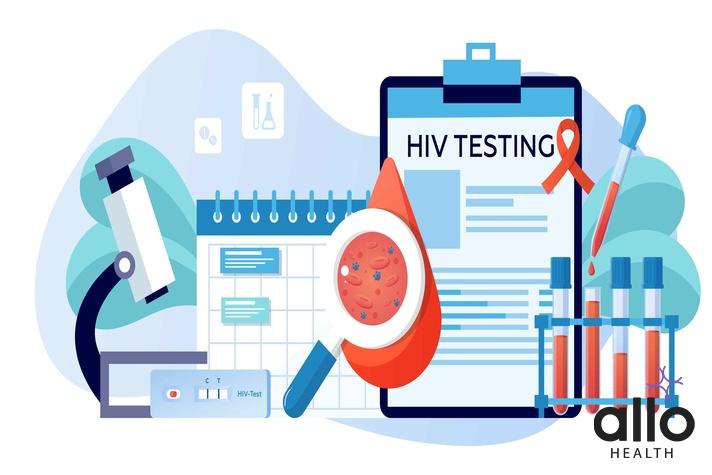Can You Get HIV If Both Partners Are Negative?

Allo Health is dedicated to personalized well-being, offering support and trusted information tailored to individual health goals. The platform emphasizes human-generated content, led by a distinguished medical team of experts, including physicians and sexual health specialists. Their commitment to credibility involves rigorous fact-checking, authoritative research, and continuous updates to ensure accurate, up-to-date information. Allo Health's unique approach goes beyond conventional platforms, providing expert-led insights and a continuous commitment to excellence, with user feedback playing a crucial role in shaping the platform's authoritative voice.

Dr Saachi has done her MBBS from Kasturba Medical College, Manipal. She has worked as a research observer in Dept. of microbiology; she also has a keen interest in the human psyche, relationships and Sexual health.
Why This Was Upated?
Our experts continually monitor the health and wellness space, and we update our articles when new information became available.
Updated on 08 March, 2024
- Article was updated as part of our commitment to diversity, equity, and inclusion.

"The following blog article provides general information and insights on various topics. However, it is important to note that the information presented is not intended as professional advice in any specific field or area. The content of this blog is for general educational and informational purposes only.
Book consultation
The content should not be interpreted as endorsement, recommendation, or guarantee of any product, service, or information mentioned. Readers are solely responsible for the decisions and actions they take based on the information provided in this blog. It is essential to exercise individual judgment, critical thinking, and personal responsibility when applying or implementing any information or suggestions discussed in the blog."
There is a common misconception that HIV can only be contracted if one partner is already infected. However, this is not entirely true. In fact, there are a number of ways that HIV can be transmitted between two HIV-negative partners. In this article, we will explore the different ways in which HIV can be transmitted and how you can protect yourself and your partner from the virus.
What Is HIV?
Specifically the CD4 cells (T cells), which play a crucial role in the body’s immune response. Over time, HIV can destroy these cells, leading to a weakened immune system and making it difficult for the body to fight off infections and diseases. If left untreated, HIV can progress to the more severe stage known as AIDS (Acquired Immunodeficiency Syndrome).
Here are some key aspects of HIV:
- Transmission:
- HIV is primarily transmitted through the exchange of certain body fluids, such as blood, semen, vaginal fluids, rectal fluids, and breast milk.
- The most common modes of transmission include unprotected sexual intercourse, sharing of needles or syringes among drug users, and mother-to-child transmission during childbirth or breastfeeding.
- HIV Life Cycle:
- Once inside the body, HIV targets CD4 cells, which are a type of white blood cell crucial for the immune system.
- The virus enters the CD4 cells, replicates itself, and then destroys the host cell in the process.
- As the virus replicates, the number of CD4 cells in the body decreases, leading to a weakened immune system.
- Stages of Infection:
- Acute HIV Infection: Shortly after infection, some individuals may experience flu-like symptoms, such as fever, fatigue, and swollen lymph nodes. However, many people with HIV do not exhibit symptoms during this early stage.
- Clinical Latency (Chronic HIV Infection): As the virus continues to replicate and the immune system fights back, the individual may not experience any symptoms for an extended period (often years). However, the virus is still active and continues to damage the immune system during this stage.
- AIDS (Acquired Immunodeficiency Syndrome): Without proper treatment, HIV infection can progress to AIDS. At this stage, the immune system is severely damaged, and the individual becomes susceptible to opportunistic infections and certain cancers.
- Diagnosis and Treatment:
- HIV can be diagnosed through blood tests that detect the presence of antibodies, antigens, or genetic material of the virus.
- Antiretroviral therapy (ART) is the standard treatment for HIV. It involves a combination of medications that suppress the virus, slow down its progression, and help the immune system recover. While ART cannot cure HIV, it can allow individuals to live long and healthy lives with the virus.
- Prevention:
- Preventive measures include practicing safe sex, using condoms consistently and correctly, avoiding sharing needles or syringes, and the use of pre-exposure prophylaxis (PrEP) for individuals at higher risk of HIV.
It is important for individuals at risk of HIV to get tested regularly and seek medical advice for proper prevention and treatment. Early detection and management can significantly improve outcomes for people living with HIV.

How Is HIV Transmitted?
HIV (Human Immunodeficiency Virus) is primarily transmitted through the exchange of certain body fluids that contain the virus. Understanding how HIV is transmitted is crucial for implementing effective preventive measures. Here are the main ways in which HIV can be transmitted:
- Unprotected Sexual Intercourse:
- The most common mode of HIV transmission is through unprotected sexual intercourse, especially vaginal or anal sex.
- The risk is higher if one of the partners is already infected with HIV.
- Using condoms consistently and correctly during sexual activity is an effective way to reduce the risk of HIV transmission.
- Sharing of Needles or Syringes:
- HIV can be transmitted through the sharing of needles or syringes used for injecting drugs.
- This risk is particularly high among individuals who inject drugs and share equipment without proper sterilization.
- Harm reduction programs, such as providing clean needles and syringes, are crucial in preventing the spread of HIV among injecting drug users.
- Mother-to-Child Transmission:
- HIV can be transmitted from an HIV-positive mother to her child during pregnancy, childbirth, or breastfeeding.
- Antiretroviral medications given to the mother during pregnancy and childbirth, as well as to the newborn, can significantly reduce the risk of transmission.
- In some cases, elective cesarean delivery may be recommended to further reduce the risk.
- Blood Transfusions and Organ Transplants (Rare):
- In the past, before rigorous screening measures were implemented, there were cases of HIV transmission through blood transfusions and organ transplants.
- Today, blood and organ donations are carefully screened for HIV and other infectious agents to prevent transmission.
- Occupational Exposure:
- Healthcare workers can be at risk of HIV transmission through accidental needlestick injuries or contact with HIV-infected blood.
- Strict adherence to universal precautions, such as using protective equipment (gloves, goggles, etc.), is essential to prevent occupational exposure.
- Sexual Assault:
- In cases of sexual assault, there is a risk of HIV transmission if one of the individuals involved is HIV-positive.
- Post-exposure prophylaxis (PEP) is a preventive measure that involves taking antiretroviral medications shortly after potential exposure to HIV, such as in cases of sexual assault.
It’s important to note that HIV is not transmitted through casual contact or day-to-day activities. It is not spread through hugging, kissing, sharing utensils, or casual contact with an HIV-positive individual. Understanding the modes of transmission helps individuals take appropriate precautions to protect themselves and others from HIV infection. Consistent and correct use of barrier methods, such as condoms, and access to prevention tools like pre-exposure prophylaxis (PrEP) are key components of HIV prevention strategies.
Testing For HIV: Understanding The Results
HIV testing is a crucial step in diagnosing and managing HIV infection. There are different types of HIV tests, each with its own strengths and purposes. Understanding the results of HIV tests is important for individuals to know their status and take appropriate actions. Here’s an overview of common HIV tests and what their results mean:
- Antibody Tests:
- These tests detect antibodies produced by the immune system in response to HIV infection.
- Most rapid tests and home testing kits are antibody tests.
- Interpretation:
- Non-Reactive (Negative): Indicates that antibodies to HIV were not detected. However, it’s important to note that there is a window period during which a person can be infected but antibodies are not yet detectable. Repeat testing may be necessary if there is ongoing risk or if the test is conducted during the window period.
- Reactive (Positive): Suggests the presence of HIV antibodies. Confirmatory testing is required to establish a positive diagnosis.
- Nucleic Acid Tests (NAT):
- These tests detect the genetic material (RNA) of the HIV virus itself rather than antibodies.
- NAT is highly sensitive and can detect HIV earlier than antibody tests.
- Interpretation:
- Detectable HIV RNA: Indicates active HIV infection. Confirmatory tests are usually performed to confirm the diagnosis.
- Combined Antigen/Antibody Tests:
- These tests detect both HIV antibodies and antigens, such as the p24 protein.
- Antigens are present in the early stages of infection, allowing for earlier detection than antibody-only tests.
- Interpretation:
- Non-Reactive (Negative): Suggests no evidence of HIV infection.
- Reactive (Positive): Requires confirmation with additional tests to establish a positive diagnosis.
- Western Blot Test:
- This is a confirmatory test used to confirm positive results from antibody tests.
- It detects specific HIV antibodies and is often used to confirm a diagnosis after an initial reactive antibody test.
- Interpretation:
- Positive Western Blot: Confirms HIV infection.
- Rapid HIV Tests:
- These tests provide results in a short amount of time, usually within 20 minutes.
- They can be antibody-only or combined antigen/antibody tests.
- Interpretation:
- Similar to other antibody or antigen/antibody tests.
- Point-of-Care Tests:
- These are rapid tests performed outside of a laboratory setting, such as in clinics or community settings.
- They provide quick results, allowing for timely intervention.
- Interpretation:
- Similar to other rapid tests.
It’s important to consult healthcare professionals for pre-test counseling, interpretation of results, and post-test counseling. A positive test result does not mean an immediate diagnosis of AIDS; further evaluation is needed to determine the stage of infection and appropriate treatment options. Early diagnosis and treatment with antiretroviral therapy (ART) can significantly improve health outcomes and reduce the risk of transmitting the virus to others.
Can You Get HIV If Both Partners Are Negative?
If both sexual partners are confirmed to be HIV-negative, the risk of contracting HIV from each other is essentially nonexistent, assuming that neither partner has engaged in any high-risk behavior or had potential exposure to the virus since their last HIV test. HIV (Human Immunodeficiency Virus) is primarily transmitted through specific body fluids such as blood, semen, vaginal fluids, rectal fluids, and breast milk.

- Recent Infection: If either partner has engaged in high-risk behavior or had potential exposure to the virus shortly before their last HIV test, there might be a risk of undetected recent infection.
- False Negative Results: HIV tests are highly accurate, but no test is perfect. There is a window period during which a person can be infected with HIV but the virus may not yet be detectable by standard testing methods. It’s important to ensure that both partners have been tested recently and that they have not engaged in any high-risk activities since their last test.
- Other STIs: While HIV may not be a concern in this specific scenario, other sexually transmitted infections (STIs) can still be transmitted even if both partners are HIV-negative. Safe sexual practices, including the use of barrier methods like condoms, can help protect against other STIs.
- Monogamy: The assumption here is that both partners are monogamous and have not engaged in sexual activities with other individuals since their last HIV test. If either partner has had sexual contact with someone else, there could be a risk of HIV transmission if that person is HIV-positive.
It is always advisable for individuals to communicate openly about their sexual health, get tested regularly for HIV and other STIs, and take appropriate precautions if engaging in sexual activities that may pose a risk. Additionally, consulting with healthcare professionals can provide personalized advice and guidance based on individual circumstances.
Most Asked Questions
-
Can you get HIV if both partners have tested negative for the virus?
No, the risk of contracting HIV is extremely low if both partners have recently tested negative for the virus. However, it is crucial to consider factors such as the window period, recent high-risk behavior, and the exclusivity of the relationship.
-
What is the window period, and how does it impact HIV transmission in negative partners?
The window period refers to the time between potential exposure to HIV and the ability of tests to detect the virus. During this period, a person can be infected but test negative. It is essential to wait for an adequate window post-exposure before relying on test results to ensure accuracy.
-
Can a false negative result occur in HIV tests, and how reliable are these tests?
While HIV tests are highly accurate, no test is perfect. False negatives may occur, especially during the window period. Regular testing, open communication, and avoiding high-risk behaviors help minimize the chances of undetected infections.
-
Are there other sexually transmitted infections (STIs) to consider even if both partners are HIV-negative?
Yes, being HIV-negative doesn't eliminate the risk of other STIs. Safe sexual practices, including the use of barrier methods, are crucial to prevent the transmission of other infections that may not be covered by routine HIV testing.
-
Is monogamy a factor in ensuring both partners remain HIV-negative?
Yes, monogamy plays a vital role. If both partners are exclusive and maintain a monogamous relationship, the risk of HIV transmission from external sources is minimized. However, honesty and communication are key to ensuring the ongoing safety and trust within the relationship.






































